Xin'an is the name of an ancient county. Its jurisdiction is similar to today's Shexian, Xiuning, Qimen, Jixi, Yixian and Wuyuan in Jiangxi, which was later called Huizhou. Within the territory, Huangshan Mountain and Qiyun Mountain stand in the north and south, and the Xin'an River flows through the territory. The scenery is beautiful and it is a refuge for war-torn Central Plains and a paradise for literati. Xin'an was most prosperous since the middle and late Ming Dynasty. The rise of Huizhou merchants led to economic prosperity and literary style in the countryside, which also laid a rich material and humanistic foundation for the development of local painting.
During the Ming and Qing Dynasties, Yi Zuo, a group of scholars from the Huizhou area fled to the mountains and forests with the arrogance of the "remnants" of the Ming Dynasty. Those who aspire to calligraphy and painting rely on the exquisite and rich collections of Huizhou famous families to "observe them morning and evening, and learn from the past", and pursue the famous works of the past sages. As a result, a group of artists with similar creative concepts and aesthetic styles was formed, known as the "Xin'an School of Painting" in the world.
The Xin'an School of Painting was a painting school active in Huizhou (today's Huangshan City) in the late Ming and early Qing dynasties.
Xin'an painters such as Ding Zan, Cheng Jiasui, and Li Yongchang in the Ming Dynasty advocated the style of "Mi Ni", with dry brushwork, simplicity and profoundness, and should be regarded as the pioneers of the Xin'an School of Painting. Jianjiangis theleader of the Xin'an School of Painting. Together with Zha Shibiao, Wang Zhirui and Sun Yi, they are known as the Four Xin'an Painting Schools.
The paintings of the Xin'an School refer to the Song and Yuan Dynasties, and the desolate mentality of the remaining painters makes them most resonate with the desolate and indifferent landscapes of Ni Yunlin among the "Four Yuan Schools". Therefore, they often start with the patriarchal Ni's techniques, but in the end they all learn from them. Nature is home.
Most of the works are based on the lofty pines and steep rocks of Huangshan Mountain. Most of them are not rendered layer by layer, and there are few complicated and dense points. Instead, they make good use of the lines of the pine spirit, cutting out the complicated and simplifying it, conveying the inner feelings of either freshness and harshness, or sparseness and simplicity. The image of distant home and mountain is given to it with profound personality connotation.
Jianjiang: Distinctive personality, solemn and quiet
Jianjiang (1610-1664), whose common surname was Jiang, given name Tao, and courtesy name Liuqi, was born in Shexian County, Anhui Province. He was born in the late Ming Dynasty. When the Qing army invaded Huizhou, he defected to the Longwu regime of the Southern Ming Dynasty and was determined to fight against the Qing Dynasty. After the failure, he became a monk in Wuyi Mountain, with the Buddhist name Hongren and other names such as Jianjiang, Wuzhi, and Meihuaguji. In 1656, he returned to his hometown at the age of 47 and stayed in a nunnery under the Lotus Peak of Huangshan Mountain.
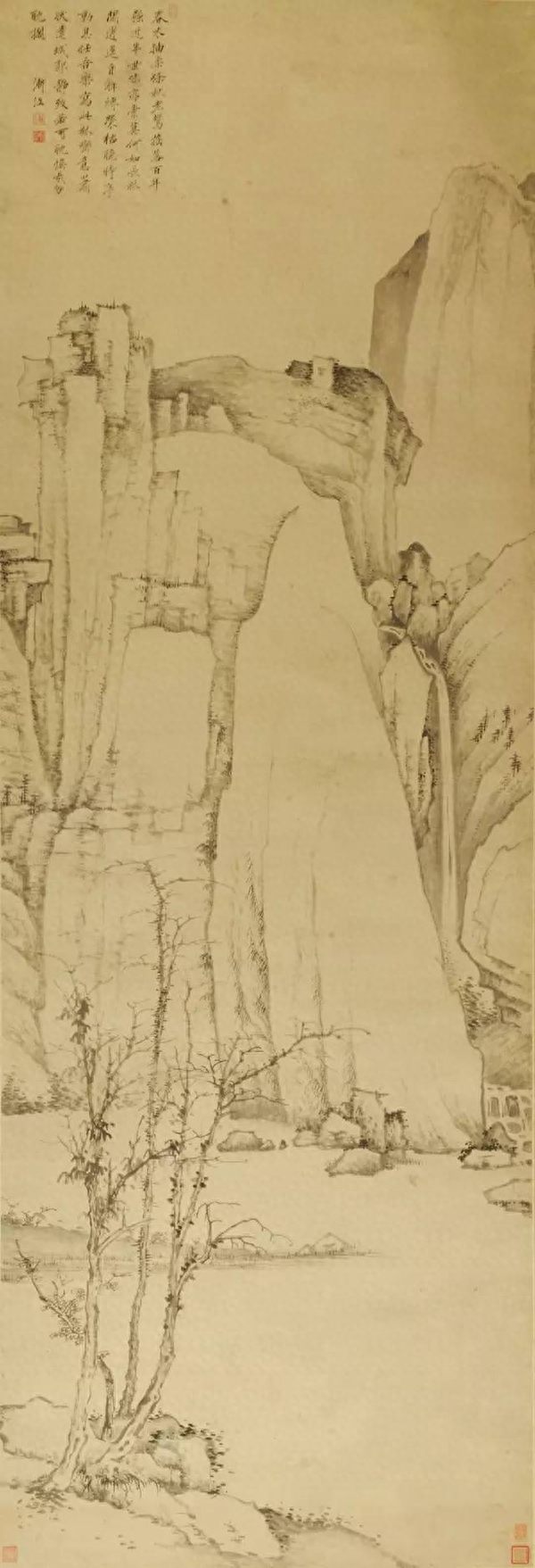
Jian Jiang's "Changlin Xiaoyao Tutang" on paper, ink, collected by Anhui Museum
Jianjiang landscape painting started with Song Dynasty paintings, and then studied the four painters of the Yuan Dynasty, especially Ni Yunlin. He learned from the predecessors, but was not bound by ancient methods.
His landscape compositions often combine real scenes with deliberate abstraction, using concise lines to outline almost geometric mountains and rocks, expressing the shape, volume and essence of the mountains, presenting an unshakable sense of power and power. Tension can be said to "take the meticulousness of the Song Dynasty people and remove the complicated descriptions, and integrate the virtual spirit of the Yuan people to strengthen the structure and character." >The style represents the essence of the early Qing Dynasty survivor paintings and established the tone of the Xin'an School of Painting.
Zha Shibiao: Meihe San people have a desolate and cold spirit.
Zha Shibiao (1615-1698), courtesy name Erzhan and nickname Meihe, was born in Xiuning, Anhui. A wealthy family collected many authentic calligraphy and paintings from the Song and Yuan Dynasties, and they have been carefully identified. After Yi Zuo of the Ming and Qing Dynasties, he abandoned his career and traveled to Hangzhou, Yangzhou, Zhenjiang, Suzhou, Jinling and other places, specializing in calligraphy and painting.
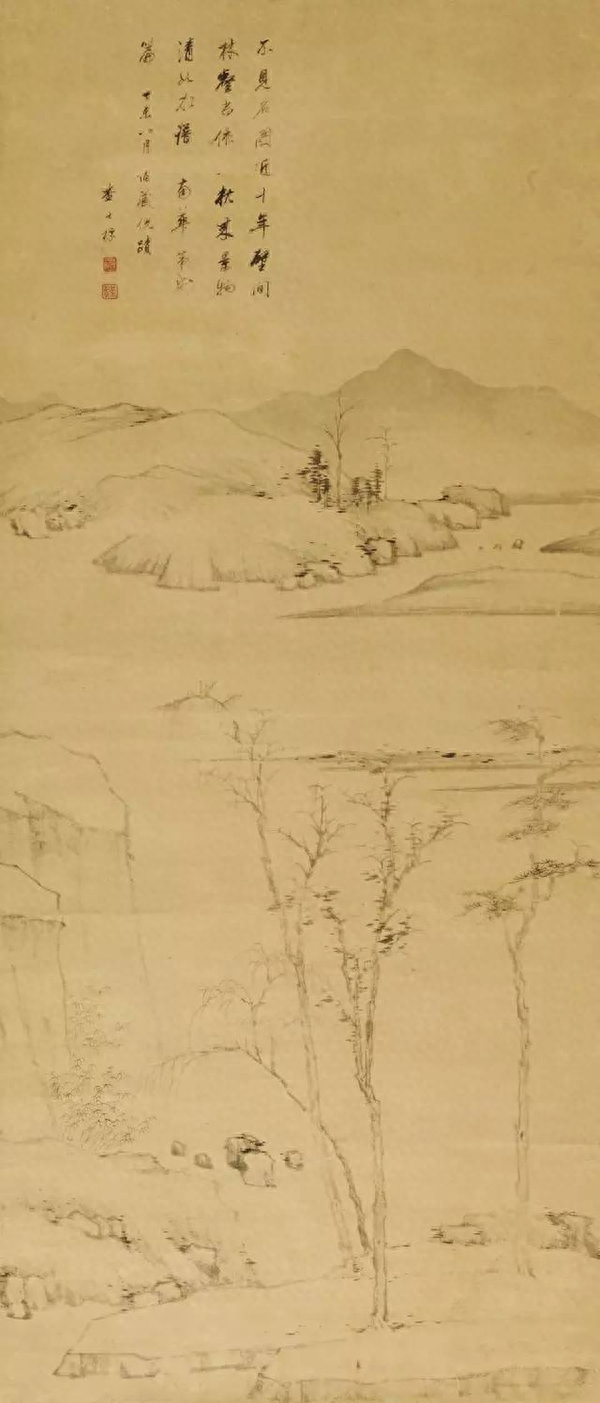
Zha Shibiao's "Scroll of Imitation Landscapes of the Yuan Dynasty" on paper, ink, collected by Anhui Museum
Ni Yunlin, who was new to landscape painting, often wrote the title "imitating Yunlin's brushwork" on his paintings. His nickname "Lazy Biao" also came from Ni Zan's nickname of "Lazy Zan", and he often used Wu Zhen's wet brush and ink to learn from Ni Yunlin. Famifu and Gao Kegong also had a lot of experience, learned from the strengths of others, and showed their talents in mastering different techniques. In various methods, their unique personal feelings can be seen, which is the so-called "wind spirit is lazy and the spirit is cold".
Sun Yi: Be diligent and diligent, and send your thoughts to Yunshan
Sun Yi (? - 1657), courtesy name Wuyi, nicknamed Shulin, also named Shichan, was born in Xiuning, Anhui. He lived in Xin'an in his early years and lived in Wuhu after entering the Qing Dynasty.
Li Yongchang, the first master of landscape painting, was "able to be light yet vigorous, simple yet meaningful". He later worked with other schools such as Wen Zhengming and Tang Yin of the Wu family, with various styles. "Records of the Paintings of the Guochao Dynasty" records that he "Landscape and other schools of the Northern and Southern sects, people think that Wen Daizhao (Wen Zhengming) is the successor". Together with Seng Jianjiang, Zha Shibiao, and Wang Zhirui, they are known as the "Xin'an Four", and together with Xiao Yuncong, the leader of the Wuhu "Gushu Sect", they are known as the "Sun Xiao".
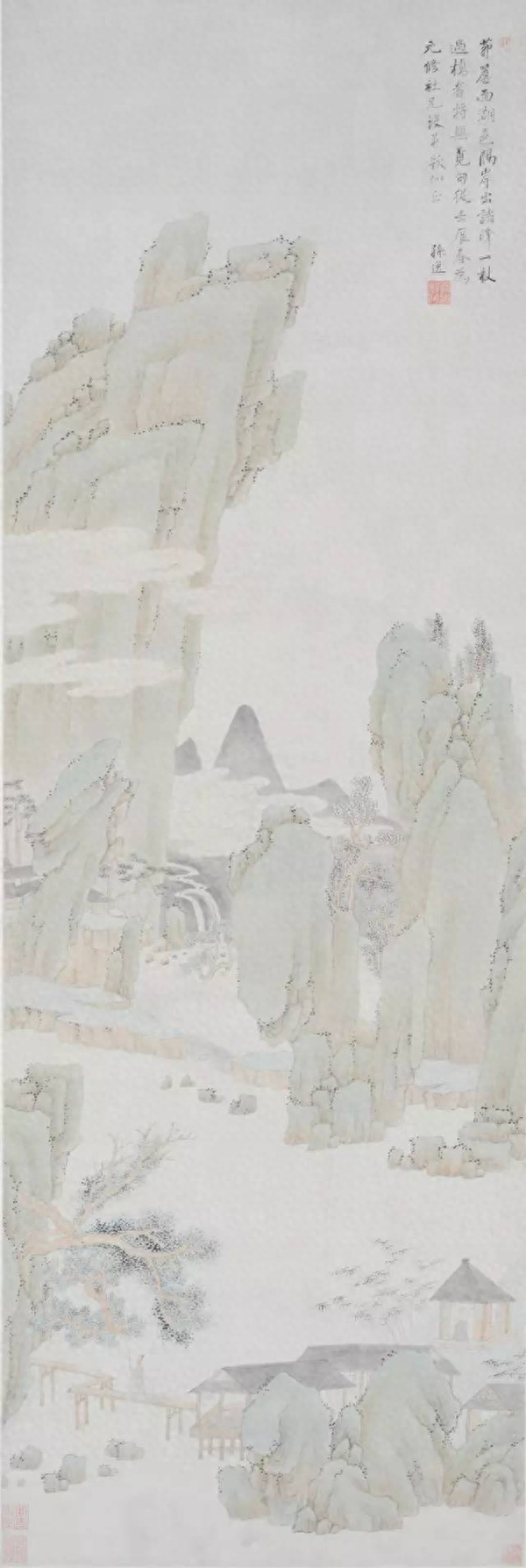
Sun Yi, Qing Dynasty, "Scroll of Looking for Sentences at the Bridge" on silk, ink and color, collected by Anhui Museum
This painting borrows the green landscape style of Erli from the Tang Dynasty, and absorbs the rigid lines used in Huizhou prints to depict the scene in shape. The bright spots on the boulder cliffs are all empty and not cracked, and are dyed with green ocher to create a clear and clean image. The lines are rich in decorative meaning, thus more effectively setting off the mood of silence and detachment. It was painted only 5 years after the author's death, and it is undoubtedly a masterpiece of his later years.
Dai Benxiao: Not adhering to ancient methods, but creating new ideas
Dai Benxiao (1621-1693), whose courtesy name was Wuzhan and whose name was Ying'a, was from He County, Anhui Province. His father, Dai Zhong, was an anti-Qing strategist and died on a hunger strike after the fall of the Ming Dynasty.
Dai Benxiao inherited his father's integrity and stayed out of office all his life. He lived in seclusion in Ying'a Mountain in commoner clothes and was friendly with Jian Jiang, Gong Xian, Shi Tao and others. Among the four masters of landscape painting, Wang Meng was especially good at fine and soft curving brushwork. Most of his works were based on real scenes of Huangshan Mountain, and he was good at using dry brushwork to express the looming changes in clouds and mountains.
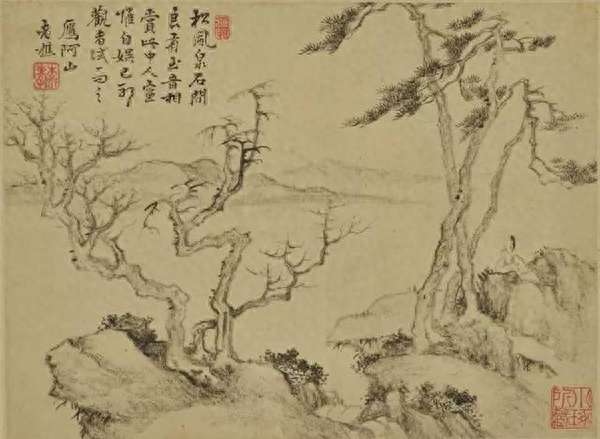
Dai Benxiao, Qing Dynasty, "Songfengquanshi Picture Scroll", ink on paper, collected by Anhui Museum
The Xin'an School mostly uses the method of simple brush and ink, and also generally makes good use of dry brush. However, the two people who have developed dry brush and dry ink to the extreme should be recommended to Cheng Sui and Dai Benxiao. Qin Zuyong's "Tongyin Theory on Painting" said: "Dai Wuzhan was originally a filial piety. He was good at dry brush painting in landscapes. He was deeply influenced by the Yuan Dynasty. It is rare to see large paintings. His sketches in volumes are similar in elegance to Cheng Muqian's brushwork. Mu Qianwu is Canggu and free from the elements. Although it is conventional, Ying'a's method is dry and dull, but full of charm. Each of the two paintings has its own strengths."
Cheng Sui: Desolate and desolate, with interesting metal and stone
Cheng Sui (1605-1691, first author 1607-1692), whose courtesy name was Mu Qian, also known as Xumin and Gu Taoren, was born in Shexian County, Anhui Province. In his early years, he traveled from Huang Daozhou and Yang Tinglin, and participated in the struggle to resist the Qing Dynasty and restore the Ming Dynasty. After the fall of the Ming Dynasty, he settled in Jinling and Yangzhou. Erudite and versatile, good at identification, skilled in medicine, and good at epigraphic research, he was the founder of the "Hui School" of seal cutting.
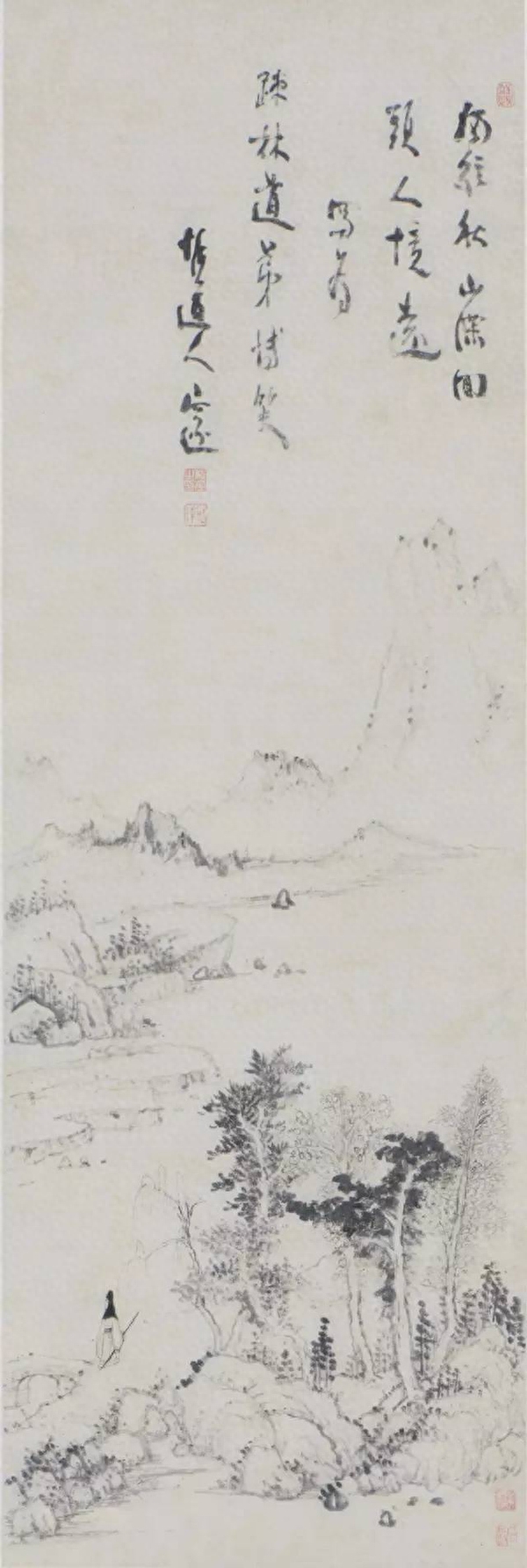
Cheng Sui, "Walking Alone to the Autumn Mountains", ink on paper, collected by Anhui Museum
In his early years, he studied landscape painting with Songjiang and Chen Jiru. He especially drew nourishment from the traditional calligraphy of Huang Gongwang and Wang Mengmi of the Yuan Dynasty, and his most distinctive features were the burnt ink of Ke's brush. Cheng Sui often uses astringent knives for seal engraving, and is good at sealing with large seals. He is simple, thick and clear, and his landscape brushwork also incorporates the simple and majestic meaning of metal and stone. Huang Binhong commented that his paintings are "dry autumn wind, moisturized by spring rain" .
Mei Qing: Turning stillness into movement, full of momentum
Mei Qing (1623-1697), courtesy name Yuangong and nickname Qushan, was a native of Xuancheng, Anhui. His family has a rich collection of calligraphy, painting and antiques, and he has a wide range of teachers.
After middle age, he gave up his career, traveled around lakes and mountains, and indulged in painting and calligraphy. He is particularly fond of the scenery of Huangshan Mountain and once said, "After my travels to Huangshan Mountain, most of the things I wrote about were written on Huangshan Mountain." During his visit to Huangshan, Mei Qing had close contacts with the Xin'an masters. His artistic concept based on the real landscape and emphasis on originality also echoed that of the Xin'an masters. He, Jianjiang and Shi Tao were praised by later generations as the "Huangshan Masters". A representative figure of the "Painting School".
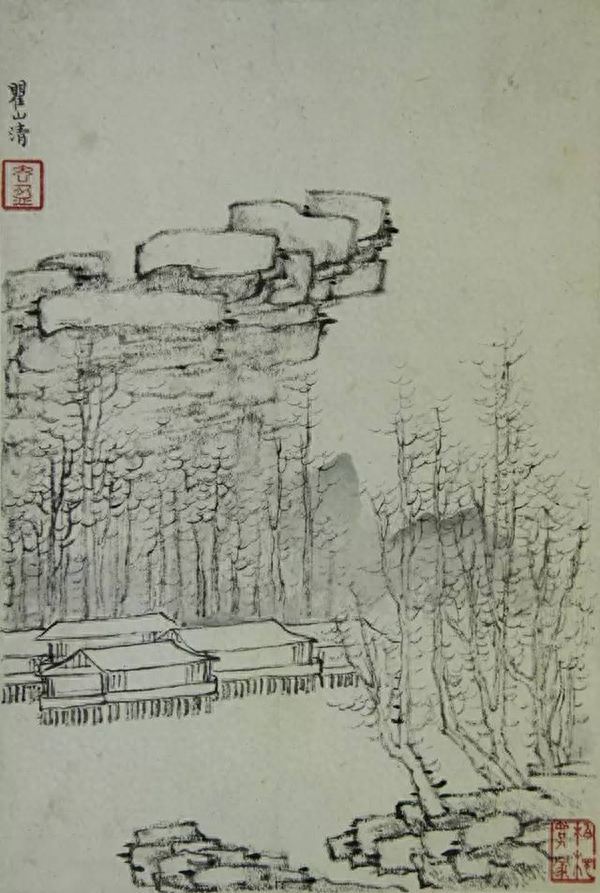
Mei Qing, Qing Dynasty, "Landscape Album", 1676, ink on paper, collected by Zhejiang Provincial Museum
The modern landscape painter He Tianjian once said that "Mei Qing captures the shadow of Huangshan Mountain, and Jianjiang captures the quality of Huangshan Mountain." Unlike Jianjiang and other Xin'an painters whose paintings are solemn, solemn and serene, Mei Qing is good at using the "moving" charm of smooth relaxation. This page is one of Huang Binhong's collections of "Landscapes of the Qing Dynasty". It is characterized by lush and graceful lines of pines, and the repeated superposition of mountains, rocks, and trees, as well as the arrangement and the change of ink shades, give the picture a unique sense of form and rhythm.
"Reflecting on the hills and valleys·Xin'an School Landscape Exhibition"
Opening at Zhejiang Museum on January 21st
The exhibition will display 70 pieces (groups) of masterpieces of the Xin'an School of Painting collected by Anhui Museum and Zhejiang Provincial Museum, with a view to presenting its artistic style and development. The exhibition runs until February 19th.
[Information] Sourced from the official WeChat account of Zhejiang Provincial Museum, subject to changes.
Previous Collections·Treasure Catalog
(Click on the title to read)
The new version of "View Exhibition" APP is now online! More timely and comprehensive exhibition news
Waiting for you there!
Long press the QR code to download

Cultural Museum/History/Culture/Exhibition News/Place Recommendations
WeChat ID: atmuseum
Weibo: @ Those Things in the Museum
475225203
Articles are uploaded by users and are for non-commercial browsing only. Posted by: Lomu, please indicate the source: https://www.daogebangong.com/en/articles/detail/jue-yi-shi-jin-fang-huai-qiu-he-xin-an-hua-pai-bi-xia-de-jue-mei-tao-hua-yuan.html

 支付宝扫一扫
支付宝扫一扫 
评论列表(196条)
测试